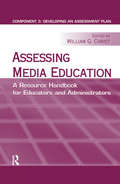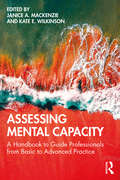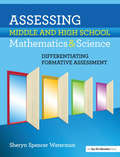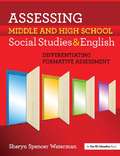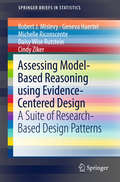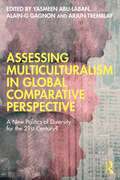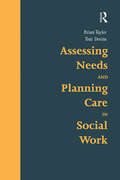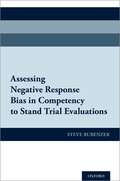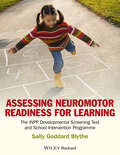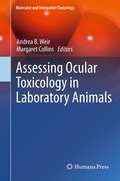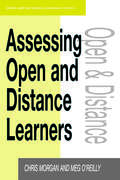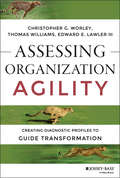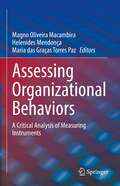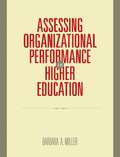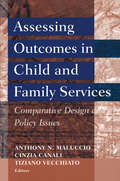- Table View
- List View
Assessing Media Education: A Resource Handbook for Educators and Administrators: Component 3: Developing an Assessment Plan (Routledge Communication Ser.)
by William G. ChristThe chapters in this component of Assessing Media Education are valuable for those who need to know how to develop an assessment plan.
Assessing Mental Capacity: A Handbook to Guide Professionals from Basic to Advanced Practice
by Janice A. Mackenzie Kate E. WilkinsonThis practical, how-to handbook provides essential resources to help clinicians and other professionals assess mental capacity in key decisions. The book illustrates the basics of capacity assessments before discussing a variety of complex issues of which professionals will need to be aware. Offering expertise from a multi-disciplinary perspective, the book provides hands-on coverage of mental capacity law (concentrating on England and Wales). This book is accompanied by online resources including semi-structured interviews and a multi-disciplinary team (MDT) questionnaire which can be downloaded and used for clinical cases, as well as further examples, information and tips. Please visit www.assessingcapacity.com. Chapters are written by a variety of different professionals with extensive experience in the assessment of mental capacity. Coverage includes: Explanations of mental capacity law and how to put it into practice across a range of settings, services and populations A "how to" approach for administering assessments of mental capacity both for professionals who are new to the area and for more experienced professionals Information on practical aspects of assessing mental capacity for commonly occurring decisions and for more specialist and complex decisions Consideration of the best interests process and Liberty Protection Safeguards (LPS). With easily accessible information, case studies, examples from case law and internationally relevant discussions on ethical issues, this is the perfect companion to help busy professionals understand complex concepts relating to mental capacity.
Assessing Mental Capacity: A Handbook to Guide Professionals from Basic to Advanced Practice
by Janice A. Mackenzie Kate E. WilkinsonThis practical, how-to handbook provides essential resources to help clinicians and other professionals assess mental capacity in key decisions. The book illustrates the basics of capacity assessments before discussing a variety of complex issues of which professionals will need to be aware. Offering expertise from a multi-disciplinary perspective, the book provides hands-on coverage of mental capacity law (concentrating on England and Wales). This book is accompanied by online resources including semi-structured interviews and a multi-disciplinary team (MDT) questionnaire which can be downloaded and used for clinical cases, as well as further examples, information and tips. Please visit www.assessingcapacity.com. Chapters are written by a variety of different professionals with extensive experience in the assessment of mental capacity. Coverage includes: Explanations of mental capacity law and how to put it into practice across a range of settings, services and populations A "how to" approach for administering assessments of mental capacity both for professionals who are new to the area and for more experienced professionals Information on practical aspects of assessing mental capacity for commonly occurring decisions and for more specialist and complex decisions Consideration of the best interests process and Liberty Protection Safeguards (LPS). With easily accessible information, case studies, examples from case law and internationally relevant discussions on ethical issues, this is the perfect companion to help busy professionals understand complex concepts relating to mental capacity.
Assessing Middle and High School Mathematics & Science: Differentiating Formative Assessment
by Sheryn Spencer-WatermanFor middle and high school teachers of mathematics and science, this book is filled with examples of instructional strategies that address students’ readiness levels, interests, and learning preferences. It shows teachers how to formatively assess their students by addressing differentiated learning targets. Included are detailed examples of differentiated formative assessment schedules, plus tips on how to collaborate with others to improve assessment processes. Teachers will learn how to adjust instruction for the whole class, for small groups, and for individuals. They will also uncover step-by-step procedures for creating their own lessons infused with opportunities to formatively assess students who participate in differentiated learning activities.
Assessing Middle and High School Mathematics & Science: Differentiating Formative Assessment
by Sheryn Spencer-WatermanFor middle and high school teachers of mathematics and science, this book is filled with examples of instructional strategies that address students’ readiness levels, interests, and learning preferences. It shows teachers how to formatively assess their students by addressing differentiated learning targets. Included are detailed examples of differentiated formative assessment schedules, plus tips on how to collaborate with others to improve assessment processes. Teachers will learn how to adjust instruction for the whole class, for small groups, and for individuals. They will also uncover step-by-step procedures for creating their own lessons infused with opportunities to formatively assess students who participate in differentiated learning activities.
Assessing Middle and High School Social Studies & English: Differentiating Formative Assessment
by Sheryn Spencer-WatermanFor middle and high school teachers teachers of social studies and English, this book is filled with examples of instructional strategies that address students’ readiness levels, interests, and learning preferences. It shows teachers how to formatively assess their students by addressing differentiated learning targets. Included are detailed examples of differentiated formative assessment schedules plus tips on how to collaborate with others to improve assessment processes. Teachers will learn how to adjust instruction for the whole class, for small groups, and for individuals. They will also uncover step-by-step procedures for creating their own lessons infused with opportunities to formatively assess students who participate in differentiated learning activities.
Assessing Middle and High School Social Studies & English: Differentiating Formative Assessment
by Sheryn Spencer-WatermanFor middle and high school teachers teachers of social studies and English, this book is filled with examples of instructional strategies that address students’ readiness levels, interests, and learning preferences. It shows teachers how to formatively assess their students by addressing differentiated learning targets. Included are detailed examples of differentiated formative assessment schedules plus tips on how to collaborate with others to improve assessment processes. Teachers will learn how to adjust instruction for the whole class, for small groups, and for individuals. They will also uncover step-by-step procedures for creating their own lessons infused with opportunities to formatively assess students who participate in differentiated learning activities.
Assessing Model-Based Reasoning using Evidence- Centered Design: A Suite of Research-Based Design Patterns (SpringerBriefs in Statistics)
by Robert J Mislevy Geneva Haertel Michelle Riconscente Daisy Wise Rutstein Cindy ZikerThis Springer Brief provides theory, practical guidance, and support tools to help designers create complex, valid assessment tasks for hard-to-measure, yet crucial, science education standards. Understanding, exploring, and interacting with the world through models characterizes science in all its branches and at all levels of education. Model-based reasoning is central to science education and thus science assessment. Current interest in developing and using models has increased with the release of the Next Generation Science Standards, which identified this as one of the eight practices of science and engineering. However, the interactive, complex, and often technology-based tasks that are needed to assess model-based reasoning in its fullest forms are difficult to develop. Building on research in assessment, science education, and learning science, this Brief describes a suite of design patterns that can help assessment designers, researchers, and teachers create tasks for assessing aspects of model-based reasoning: Model Formation, Model Use, Model Elaboration, Model Articulation, Model Evaluation, Model Revision, and Model-Based Inquiry. Each design pattern lays out considerations concerning targeted knowledge and ways of capturing and evaluating students’ work. These design patterns are available at http://design-drk.padi.sri.com/padi/do/NodeAction?state=listNodes&NODE_TYPE=PARADIGM_TYPE. The ideas are illustrated with examples from existing assessments and the research literature.
Assessing Multiculturalism in Global Comparative Perspective: A New Politics of Diversity for the 21st Century?
by Yasmeen Abu-Laban Alain-G. Gagnon Arjun TremblayIn Assessing Multiculturalism in Global Comparative Perspective, a group of leading scholars come together in a multidisciplinary collection to assess multiculturalism through an international comparative perspective. Multiculturalism today faces challenges like never before, through the concurrent rise of populism and white supremacist groups, and contemporary social movements mobilizing around alternative ideas of decolonization, anti-racism and national self-determination Taking these challenges head on, and with the backdrop that the term multiculturalism originated in Canada before going global, this collection of chapters presents a global comparative view of multiculturalism, through both empirical and normative perspectives, with the overarching aim of comprehending multiculturalism’s promise, limitations, contemporary challenges, trajectory and possible futures. Collectively, the chapters provide the basis for a critical assessment of multiculturalism’s first 50 years, as well as vital insight into whether multiculturalism is best equipped to meet the distinct challenges characterizing this juncture of the 21st century. With coverage including the Americas, Europe, Oceania, Africa and Asia, and thematic coverage of citizenship, religion, security, gender, Black Lives Matter and the post-pandemic order, Assessing Multiculturalism in Global Comparative Perspective presents a comprehensively global collection that is indispensable reading for scholars and students of diversity in the 21st century.
Assessing Multiculturalism in Global Comparative Perspective: A New Politics of Diversity for the 21st Century?
by Yasmeen Abu-Laban, Alain-G Gagnon and Arjun TremblayIn Assessing Multiculturalism in Global Comparative Perspective, a group of leading scholars come together in a multidisciplinary collection to assess multiculturalism through an international comparative perspective. Multiculturalism today faces challenges like never before, through the concurrent rise of populism and white supremacist groups, and contemporary social movements mobilizing around alternative ideas of decolonization, anti-racism and national self-determination Taking these challenges head on, and with the backdrop that the term multiculturalism originated in Canada before going global, this collection of chapters presents a global comparative view of multiculturalism, through both empirical and normative perspectives, with the overarching aim of comprehending multiculturalism’s promise, limitations, contemporary challenges, trajectory and possible futures. Collectively, the chapters provide the basis for a critical assessment of multiculturalism’s first 50 years, as well as vital insight into whether multiculturalism is best equipped to meet the distinct challenges characterizing this juncture of the 21st century. With coverage including the Americas, Europe, Oceania, Africa and Asia, and thematic coverage of citizenship, religion, security, gender, Black Lives Matter and the post-pandemic order, Assessing Multiculturalism in Global Comparative Perspective presents a comprehensively global collection that is indispensable reading for scholars and students of diversity in the 21st century.
Assessing Needs and Planning Care in Social Work
by Brian Taylor Toni DevineThe assessment of needs and the process of planning care are central issues in modern social work practice. Skilled assessment of client needs and strengths is essential to effective planning and efficient provision of quality social work services including both counselling and personal care. The focus of this book is on the development of the skills required at each stage of the social work process: assessment, care planning, implementation and evaluation. Throughout the book a balance is maintained between the focus on client involvement and the role of the social worker in an agency. The latter part of the book addresses practical issues in developing new approaches to assessment and care planning: primary workers, individual support and managing change. Social work practitioners, managers and trainers and students on qualifying and pre-qualifying training will find this an invaluable aid to the development of sound and yet creative practice.
Assessing Needs and Planning Care in Social Work
by Brian Taylor Toni DevineThe assessment of needs and the process of planning care are central issues in modern social work practice. Skilled assessment of client needs and strengths is essential to effective planning and efficient provision of quality social work services including both counselling and personal care. The focus of this book is on the development of the skills required at each stage of the social work process: assessment, care planning, implementation and evaluation. Throughout the book a balance is maintained between the focus on client involvement and the role of the social worker in an agency. The latter part of the book addresses practical issues in developing new approaches to assessment and care planning: primary workers, individual support and managing change. Social work practitioners, managers and trainers and students on qualifying and pre-qualifying training will find this an invaluable aid to the development of sound and yet creative practice.
Assessing Negative Response Bias in Competency to Stand Trial Evaluations
by Steven J. RubenzerEvaluations of a defendant's competence to stand trial (CST) are probably the most frequently performed forensic evaluations, with estimates in the United States ranging from 60,000 to 70,000 annually. In order for CST evaluations to be considered thorough and accurate, examiners must assess for possible lack of cooperation, feigning, or malingering - the intentional production or gross exaggeration of false or grossly exaggerated physical or psychiatric symptoms, motivated by external incentives. Yet, there are accounts that CST examiners often do not assess for negative response bias, and even if they do nevertheless fail to identify a considerable number of examinees that do feign. Assessing Negative Response Bias in Competency to Stand Trial Evaluations provides readers with a comprehensive guide to assessing whether a defendant has feigned mental impairment during a competency to stand trial evaluation, or simply did not put forth his/her best effort. This book reviews the literature on assessing feigning and negative response bias, with particular focus on issues, tests, and data relevant to CST evaluations, and examines proposed criteria and statistical methods of determining and classifying assessment results. It introduces readers to aspects of the vibrant neuropsychological response style literature, an area many forensic psychologists appear to have overlooked. Additionally, it offers recommendations for research and policy regarding the parameters of CST assessment.
Assessing Negative Response Bias in Competency to Stand Trial Evaluations
by Steven J. RubenzerEvaluations of a defendant's competence to stand trial (CST) are probably the most frequently performed forensic evaluations, with estimates in the United States ranging from 60,000 to 70,000 annually. In order for CST evaluations to be considered thorough and accurate, examiners must assess for possible lack of cooperation, feigning, or malingering - the intentional production or gross exaggeration of false or grossly exaggerated physical or psychiatric symptoms, motivated by external incentives. Yet, there are accounts that CST examiners often do not assess for negative response bias, and even if they do nevertheless fail to identify a considerable number of examinees that do feign. Assessing Negative Response Bias in Competency to Stand Trial Evaluations provides readers with a comprehensive guide to assessing whether a defendant has feigned mental impairment during a competency to stand trial evaluation, or simply did not put forth his/her best effort. This book reviews the literature on assessing feigning and negative response bias, with particular focus on issues, tests, and data relevant to CST evaluations, and examines proposed criteria and statistical methods of determining and classifying assessment results. It introduces readers to aspects of the vibrant neuropsychological response style literature, an area many forensic psychologists appear to have overlooked. Additionally, it offers recommendations for research and policy regarding the parameters of CST assessment.
Assessing Neuromotor Readiness for Learning: The INPP Developmental Screening Test and School Intervention Programme
by Sally Goddard BlytheAssessing Neuromotor Readiness for Learning is a substantially revised and expanded edition of a long established INPP training manual that has been consistently proven in practice. The package includes tests for children, a developmental movement programme, and information about online access to INPP video training materials. Based on the proven INPP model for neuromotor development screening and intervention, which is unique in having been rigorously evaluated in research and practice Expands and revises an INPP manual which has previously only been available to training customers, and which is a foundation stone of the overall INPP approach Places emphasis on children's physical development and how neuro-motor skills provide the foundations for learning success. The package includes batteries of tests for younger and older children, a developmental movement programme This book may be supported and enhanced by INPP video training materials and score sheets, available for download purchase from the INPP website
Assessing Neuromotor Readiness for Learning: The INPP Developmental Screening Test and School Intervention Programme
by Sally Goddard BlytheAssessing Neuromotor Readiness for Learning is a substantially revised and expanded edition of a long established INPP training manual that has been consistently proven in practice. The package includes tests for children, a developmental movement programme, and information about online access to INPP video training materials. Based on the proven INPP model for neuromotor development screening and intervention, which is unique in having been rigorously evaluated in research and practice Expands and revises an INPP manual which has previously only been available to training customers, and which is a foundation stone of the overall INPP approach Places emphasis on children's physical development and how neuro-motor skills provide the foundations for learning success. The package includes batteries of tests for younger and older children, a developmental movement programme This book may be supported and enhanced by INPP video training materials and score sheets, available for download purchase from the INPP website
Assessing Ocular Toxicology in Laboratory Animals (Molecular and Integrative Toxicology)
by Andrea B Weir and Margaret CollinsOcular toxicity is routinely assessed in toxicology studies conducted for regulatory purposes. Ocular anatomy and physiology and the assessment of ocular toxicity itself can be challenging to scientists involved in the safety assessment of pharmaceuticals, pesticides and other agents. Anatomical and physiological differences between species can impact the nature of ocular effects observed following intended or unintended exposure of ocular tissues to xenobiotics. Ocular Toxicity in Laboratory Animals provides a concise reference addressing ocular anatomy and physiology across species that will enhance the design and interpretation of toxicology studies conducted for regulatory purposes. The book provides an overview of routine and advanced techniques that are used to assess ocular toxicity including slit lamp biomicroscopy, indirect ophthalmoscopy, electrophysiology and imaging methods for the anterior and posterior segments of the eye. Additionally, the book defines the regulatory expectations for pharmaceuticals intended to treat ocular diseases and for other non-pharmaceutical regulated chemicals. With contributions from experts in the field, Ocular Toxicity in Laboratory Animals is an authoritative, accessible guide for toxicologists and other scientists involved in conducting toxicology studies for regulatory purposes and/or reviewing data from such studies.
Assessing Open and Distance Learners (Open and Flexible Learning Series)
by Chris Morgan Meg (both O'ReillyResearch has indicated that assessment is a key factor in student learning. This book details the issues of assessment in the open and distance learning field, where changes in budgets, the location and environment of the students and other factors have prompted innovations in assessment.
Assessing Open and Distance Learners (Open and Flexible Learning Series)
by Chris Morgan Meg (both O'ReillyResearch has indicated that assessment is a key factor in student learning. This book details the issues of assessment in the open and distance learning field, where changes in budgets, the location and environment of the students and other factors have prompted innovations in assessment.
Assessing Organization Agility: Creating Diagnostic Profiles to Guide Transformation (J-B Short Format Series)
by Christopher G. Worley Thomas D. Williams Edward E. Lawler IIIIn-depth agility evaluation for a more efficient response to change Assessing Organization Agility provides a clear, concise roadmap to improved implementation of change. Written by two organizational researchers at USC's Center for Effective Organizations and a management consultant with Strategy& (formerly Booz & Company), this book provides the means for assessing an organization's agility and formulating an improvement plan. Beginning with a discussion about the meaning of "agility," the authors enumerate the various contributing factors that affect how quickly an organization responds to change, and the efficiency of the response. An agility survey shows readers how their own organization compares in terms of both perception and implementation, allowing the formulation of an "Agility Profile" that can point out strengths while highlighting areas in need of improvement. Case studies demonstrate the real-world impact of effective agility strategy, and example scenarios illustrate improved responses by each agility "type." Eighty percent of large-scale organizations fail to meet their objectives, and poor agility is often to blame. Organizations respond to changes in the marketplace, economy, and society by implementing changes in their processes and procedures, but planning and implementing change takes time. During that time, the context of the initial decision frequently evolves, leaving the organization one step behind. Agility is the ability to quickly implement change without sacrificing strategy, and Assessing Organization Agility helps readers to: Discover the organizational/operational factors that contribute to agility Assess current agility from all perspectives, highlighting areas for improvement Implement processes and procedures that streamline change events Maintain forward trajectory with adjustments to strategy and implementation The current pace of technical, competitive, and environmental change is faster than ever before, and response requirements are far more complex and sophisticated. In this turbulent environment, agility can mean the difference between success and stagnation. Assessing Organization Agility asks the questions and provides the answers that lead to better organizational reflex and more effective response.
Assessing Organization Agility: Creating Diagnostic Profiles to Guide Transformation (J-B Short Format Series)
by Christopher G. Worley Thomas D. Williams Edward E. Lawler IIIIn-depth agility evaluation for a more efficient response to change Assessing Organization Agility provides a clear, concise roadmap to improved implementation of change. Written by two organizational researchers at USC's Center for Effective Organizations and a management consultant with Strategy& (formerly Booz & Company), this book provides the means for assessing an organization's agility and formulating an improvement plan. Beginning with a discussion about the meaning of "agility," the authors enumerate the various contributing factors that affect how quickly an organization responds to change, and the efficiency of the response. An agility survey shows readers how their own organization compares in terms of both perception and implementation, allowing the formulation of an "Agility Profile" that can point out strengths while highlighting areas in need of improvement. Case studies demonstrate the real-world impact of effective agility strategy, and example scenarios illustrate improved responses by each agility "type." Eighty percent of large-scale organizations fail to meet their objectives, and poor agility is often to blame. Organizations respond to changes in the marketplace, economy, and society by implementing changes in their processes and procedures, but planning and implementing change takes time. During that time, the context of the initial decision frequently evolves, leaving the organization one step behind. Agility is the ability to quickly implement change without sacrificing strategy, and Assessing Organization Agility helps readers to: Discover the organizational/operational factors that contribute to agility Assess current agility from all perspectives, highlighting areas for improvement Implement processes and procedures that streamline change events Maintain forward trajectory with adjustments to strategy and implementation The current pace of technical, competitive, and environmental change is faster than ever before, and response requirements are far more complex and sophisticated. In this turbulent environment, agility can mean the difference between success and stagnation. Assessing Organization Agility asks the questions and provides the answers that lead to better organizational reflex and more effective response.
Assessing Organizational Behaviors: A Critical Analysis of Measuring Instruments
by Magno Oliveira Macambira Helenides Mendonça Maria das Graças Torres PazThis book fills a gap in international literature by providing critical reviews on variables of organizational behavior and the main psychological instruments developed to measure them. Measuring instruments developed with theoretical and methodological rigor in the field of Organizational and Work Psychology can contribute to the development of diagnostic analyses to enable organizations to implement the evidence-based changes required for their survival. These changes demand diagnoses based on precise assessments of organizational and individual variables, but many times the professionals responsible for conducting these assessments are not sure of what is the best measuring instrument available. This book is intended to serve as a guide to these professionals. The volume is divided in two parts. The first part brings together chapters dedicated to the following micro-organizational variables: Job Crafting, reactions to organizational change, Psychological Wellbeing at Work, Bridge Employment Assessment in the Work-Retirement Transition, Resilience at Work, and Leadership in Organizations. The second part presents the state-of-the-art of research on the following macro-organizational constructs: Quality of Life at Work, Organizational Climate for Creativity, Values and Organizations, Assessments of Organizational Support, and Contributions by Social Networks Analysis and Organizational Effectiveness. The last chapter presents a critical discussion about the nature and future of organization behavior measuring. Assessing Organizational Behaviors: A Critical Analysis of Measuring Instruments is intended to help market professionals select the diagnostic instruments that best fit into their organizational reality in order to correctly assess organizational behavior. The book will also be of interest to researchers and students in the field of Organizational and Work Psychology as it provides comprehensive overviews of a wide range of instruments developed to measure different variables of organizational behavior.
Assessing Organizational Performance in Higher Education (Research Methods for the Social Sciences)
by Barbara A. Miller Ph.D.The book provides a full complement of assessment technologies that enable leaders to measure and evaluate performance using qualitative and quantitative performance indicators and reference points in each of seven areas of organizational performance. While these technologies are not new, applying them in a comprehensive assessment of the performance of both academic and administrative organization in higher education is a true innovation. Assessing Organizational Performance in Higher Education defines four types of assessment user groups, each of which has unique interest in organizational performance. This offers a new perspective on who uses performance results and why they use them. These varied groups emphasize that assessment results must be tailored to fit the needs of specific groups, that “one-size-fits-all” does not apply in assessment. An assessment process must be robust and capable of delivering the right information at the right time to the right user group.
Assessing Outcomes in Child and Family Services: Comparative Design and Policy Issues (Modern Applications Of Social Work Ser.)
by Anthony N. MaluccioIn this collective portrait, editors and authors do not attempt to draw systematic, country-by-country comparisons. Given the magnitude of the issues, they believed that it would be inappropriate to paint with too broad a stroke. What they have accomplished, however, is to codify and identify what the participants repeatedly noted in regard to issues and difficulties inherent in conducting outcome evaluation. These include: varying definitions of outcome; complexities in measuring outcomes of particular interventions with different groups of consumers and documenting the effectiveness of the intervention; the tendency to focus on evaluation of process more than outcome; the challenge of involving practitioners in the evaluation task, in part because its value is unclear to them or perceived as distant or untrustworthy; the typical inadequacy of resources available for systematic evaluation; and the need to inject rigor into the design and execution of evaluation projects. The authors demonstrate strong conviction about sharing research expertise across national boundaries; learning through each other how to cope with organizational impediments to cross-national collaboration; and strengthening the interaction between practice and research. Their contributions suggest that there is wide interest in pursuing cross-national collaboration. In recent years, largely in response to demands by their funding sources for accountability, assessment of performance, and cost effectiveness, researchers in human services have been devoting increased attention to outcome evaluation. Limited attention, however, has been given to the findings of evaluation studies conducted in different countries. The present volume has been organized and edited to address the task of learning from outcome research across the world. Its goal, an extension of a major goal of the human services in any one country, is to improve life chances of vulnerable children and youth.
Assessing Outcomes in Child and Family Services: Comparative Design and Policy Issues
by Anthony N. MaluccioIn this collective portrait, editors and authors do not attempt to draw systematic, country-by-country comparisons. Given the magnitude of the issues, they believed that it would be inappropriate to paint with too broad a stroke. What they have accomplished, however, is to codify and identify what the participants repeatedly noted in regard to issues and difficulties inherent in conducting outcome evaluation. These include: varying definitions of outcome; complexities in measuring outcomes of particular interventions with different groups of consumers and documenting the effectiveness of the intervention; the tendency to focus on evaluation of process more than outcome; the challenge of involving practitioners in the evaluation task, in part because its value is unclear to them or perceived as distant or untrustworthy; the typical inadequacy of resources available for systematic evaluation; and the need to inject rigor into the design and execution of evaluation projects. The authors demonstrate strong conviction about sharing research expertise across national boundaries; learning through each other how to cope with organizational impediments to cross-national collaboration; and strengthening the interaction between practice and research. Their contributions suggest that there is wide interest in pursuing cross-national collaboration. In recent years, largely in response to demands by their funding sources for accountability, assessment of performance, and cost effectiveness, researchers in human services have been devoting increased attention to outcome evaluation. Limited attention, however, has been given to the findings of evaluation studies conducted in different countries. The present volume has been organized and edited to address the task of learning from outcome research across the world. Its goal, an extension of a major goal of the human services in any one country, is to improve life chances of vulnerable children and youth.
